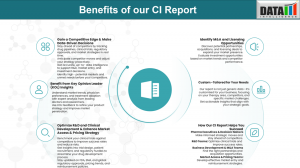Atypical Hemolytic Uremic Syndrome (aHUS): Breaking the Boundaries of Traditional Treatment | Competitive Intelligence
Next-gen aHUS treatments are shifting from IV infusions to oral and subcutaneous options-offering new hope in safety, efficacy, and patient ease.
Book Your Free CI Consultation Call: https://www.datamintelligence.com/strategic-insights/ci/atypical-hemolytic-uremic-syndrome-ahus
Historically, the clinical landscape for aHUS treatment was limited and reactive. However, the emergence of complement inhibitors such as Soliris (eculizumab) and Ultomiris (ravulizumab) has dramatically transformed patient outcomes. These targeted therapies block the complement component C5, thereby halting the terminal pathway responsible for endothelial injury. Despite their efficacy, these treatments bring challenges-namely, high costs, intravenous dosing burdens, and long-term immunosuppression.
Epidemiology and Disease Burden
Though rare, aHUS is now recognized more frequently due to improved diagnostic capabilities and awareness. Incidence estimates suggest approximately 1 to 2 cases per million population annually, with a higher prevalence in pediatric patients and young adults. Despite being uncommon, the economic and clinical burden is significant. Frequent hospitalizations, renal replacement therapies, and lifelong medication usage make it a resource-intensive condition for both patients and health systems.
Looking ahead, as diagnosis rates continue to rise and access to therapy improves globally, the treated patient population is expected to expand steadily over the next decade.
Market Leaders: Soliris and Ultomiris
Soliris, the first-in-class anti-C5 monoclonal antibody, has long been the backbone of aHUS management. Delivered via intravenous infusion every two weeks, it provides rapid disease control and kidney function stabilization. Ultomiris, a long-acting version of Soliris, offers dosing every eight weeks and has quickly gained traction due to its extended half-life and comparable efficacy.
While both drugs offer life-altering benefits, their IV delivery model and high cost present logistical and economic hurdles-particularly in resource-limited settings. Furthermore, patients on chronic complement inhibition face elevated risks of infections, especially from encapsulated organisms like Neisseria meningitidis, requiring mandatory vaccination and close monitoring.
Biosimilars Enter the Arena: Expanding Access
To address cost constraints, biosimilars such as Bkemv and EPYSQLI have recently entered the market. Both mirror the efficacy and safety profile of Soliris but at reduced prices. This has significant implications for healthcare systems seeking cost-effective treatment options and for patients in emerging markets where branded biologics were previously out of reach.
The entry of biosimilars is expected to trigger pricing pressure on originator brands and encourage broader adoption of complement blockade therapy in previously underserved regions.
Emerging Innovations: Convenience Redefined
The next wave of innovation in aHUS centers around patient-centric improvements-most notably the shift from intravenous to oral or subcutaneous delivery.
Fabhalta (Iptacopan), an oral complement factor B inhibitor, represents a potentially game-changing option. By targeting the alternative pathway upstream of C5, Fabhalta may offer broader complement control. Its oral daily dosing also addresses the burden of frequent infusions, enhancing quality of life and adherence.
Another frontrunner is Crovalimab (Piasky), a subcutaneous anti-C5 monoclonal antibody recently approved in several regions. Its monthly SC administration empowers patients with greater autonomy and reduces hospital visits-especially appealing for younger, working patients or those in remote areas.
These innovations are not merely incremental-they have the potential to disrupt the current therapeutic paradigm, offering alternatives that align more closely with patient preferences.
Pipeline Outlook: What’s Next?
The aHUS pipeline includes promising assets in various stages of development, including novel monoclonal antibodies, small molecules, and even RNA interference (RNAi) therapies. These next-gen modalities aim to deliver differentiated value-whether through new mechanisms of action, improved safety profiles, or enhanced pharmacokinetics.
Key targets include:
- Complement factor B and C3, which offer upstream inhibition for more comprehensive control.
- Gene therapies under preclinical evaluation, aiming for long-term or potentially curative outcomes.
- Oral agents and self-administered injectables, reducing the logistical barriers of hospital-based care.
While Soliris and Ultomiris set a high bar for efficacy and safety, pipeline therapies must offer clear advantages-either in administration, tolerability, or cost-effectiveness-to capture significant market share.
Target Opportunity Profile (TOP): Where the Gaps Lie
To secure a strong foothold in the evolving aHUS market, developers must address the following unmet needs:
- Convenience: Intravenous dosing every two to eight weeks limits patient freedom. Oral or subcutaneous routes are increasingly preferred.
- Affordability: The high cost of branded therapies restricts global access. Cost-effective alternatives or pricing models will be key.
- Safety: While current therapies are generally well tolerated, they carry infection risks. Novel agents must aim to reduce immunosuppression-related complications.
- Innovation in Mechanism: Moving beyond C5 to upstream targets may offer added efficacy in difficult or resistant cases.
- Real-World Outcomes: Long-term data on kidney preservation, survival, and quality of life will influence payer decisions and treatment guidelines.
Competitive Dynamics: A Market in Transition
The market for aHUS treatment is no longer defined solely by biologics delivered via infusion centers. With oral small molecules like Fabhalta and subcutaneous agents like Crovalimab gaining traction, the competitive landscape is undergoing rapid transformation.
Manufacturers must now compete not only on efficacy but also on convenience, safety, price, and patient experience. Biosimilars are squeezing margins while expanding access. Meanwhile, pipeline entrants promise to reset expectations entirely-with oral, gene-based, and potentially curative approaches in development.
Download Free Sample Report: https://www.datamintelligence.com/strategic-insights/sample/atypical-hemolytic-uremic-syndrome-ahus
Conclusion
The treatment of atypical hemolytic uremic syndrome has come a long way-from managing life-threatening relapses with supportive care to providing targeted, disease-modifying therapy. But the next frontier is patient-centric: offering safe, effective, and affordable treatment that fits seamlessly into patients’ lives.
Oral drugs like Fabhalta and injectables like Crovalimab mark a pivotal shift, challenging the status quo and opening the door to more personalized and accessible care. As biosimilars democratize access and innovation drives differentiation, the aHUS market is poised for significant evolution in the years ahead.
Read Related CI Reports:
1. Eosinophilic Esophagitis | Competitive Intelligence
2. Warm Autoimmune Hemolytic Anemia | CI Insights
Sai Kumar
DataM Intelligence 4market Research LLP
+1 877-441-4866
email us here
Visit us on social media:
LinkedIn
X
Legal Disclaimer:
EIN Presswire provides this news content "as is" without warranty of any kind. We do not accept any responsibility or liability for the accuracy, content, images, videos, licenses, completeness, legality, or reliability of the information contained in this article. If you have any complaints or copyright issues related to this article, kindly contact the author above.
Defense Communication Intelligence Market Set to Expand At a Staggering 6.4% CAGR, Reaching $37.4 Billion by 2033
Chronic Traumatic Encephalopathy Report 2025 – For Strategy Officers and Market Intelligence Teams
Clinical Laboratory Services Report 2025 – For Strategy Officers And Market Intelligence Teams
Więcej ważnych informacji
 Jedynka Newserii
Jedynka Newserii

 Jedynka Newserii
Jedynka Newserii

Konsument

Proces deregulacji nie dotyczy branży tytoniowej. Jest propozycja kolejnej ustawy w ciągu kilku miesięcy
Najpierw wprowadzenie podatku akcyzowego na saszetki nikotynowe, potem propozycja przepisów, które zmierzają do wycofania tych produktów z rynku – przedstawiciele środowisk biznesowych podkreślają, że przygotowywane przez resort zdrowia przepisy wprowadzają chaos legislacyjny w branży tytoniowej. To tym bardziej dziwi przedsiębiorców, że stoi w opozycji do prowadzonego przez rząd procesu deregulacji w gospodarce. W dodatku może mieć negatywne skutki dla budżetu państwa i doprowadzić do skokowego wzrostu szarej strefy.
Bankowość
Grzyby rozkładające tekstylia nagrodzone w konkursie ING. 1 mln zł trafi na innowacyjne projekty dla zrównoważonych miast

Firma Myco Renew, która opracowała technologię rozkładającą tekstylia za pomocą grzybów, została laureatem siódmej edycji Programu Grantowego ING. Motywem przewodnim konkursu skierowanego do start-upów i młodych naukowców był tym razem zrównoważony rozwój miast i społeczności. Łącznie na nagrodzone innowacyjne projekty trafił 1 mln zł. Wśród nich są także bezzałogowe statki powietrzne dostarczające defibrylatory czy system do zbierania deszczówki w blokach.
Prawo
Trwają próby wzmocnienia dialogu społecznego. Niespokojne czasy wymuszają większe zaangażowanie społeczeństwa w podejmowanie decyzji

Według zapowiedzi szefowej Komisji Europejskiej Ursuli von der Leyen głos partnerów społecznych i dialog społeczny będą stały w centrum procesu decyzyjnego w Europie. Taki jest cel podpisanego w marcu Paktu na rzecz europejskiego dialogu społecznego. Potrzeba wzmocnienia głosu społeczeństwa jest również podkreślana na forum krajowym. Rząd planuje reformę Rady Dialogu Społecznego, by usprawnić pracę tej instytucji, a przedsiębiorcy wzywają do rzetelnego konsultowania ze stroną społeczną ustaw, które wychodzą z rządu.
Partner serwisu
Szkolenia

Akademia Newserii
Akademia Newserii to projekt, w ramach którego najlepsi polscy dziennikarze biznesowi, giełdowi oraz lifestylowi, a także szkoleniowcy z wieloletnim doświadczeniem dzielą się swoją wiedzą nt. pracy z mediami.

![37,5 proc. środków z Planu Społeczno-Klimatycznego trafi na walkę z ubóstwem transportowym. Organizacje branżowe apelują o zmianę priorytetowych projektów [DEPESZA]](https://www.newseria.pl/files/1097841585/rower3,w_85,_small.jpg)







.gif)

 |
| |
| |
|